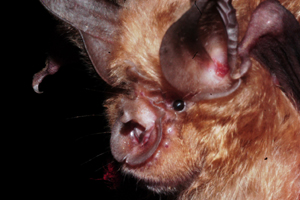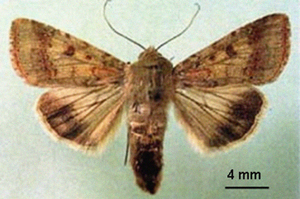Co-evolutionary arms race gives moths a head start
08 September 2008Zoologists have long believed that the high proportion of moths in the diet of some bats is linked to their high-frequency echolocation calls at allotonic frequencies, those outside the typical hearing range of most moths (20 to 60kHz).
But new research by UCT zoologist Professor David Jacobs, holder of the SARCHI chair in Animal Evolution and Systematics, and his co-authors from the US, published in Behavioural Ecology, has delivered a neat twist to the tale.
 |
||||
| Horseshoe bat | ||||
In a study of African moths and Cape horseshoe bats (Rhinolophus capensis) at Hothole Cave in the Southern Cape's De Hoop Nature Reserve, Jacobs and his team put their allotonic frequency hypothesis to the test.
And in a habitat favoured by the Cape Bulbul (Pycnonotus capensis), a voracious predator of moths, they added another factor to the mix.
Could the moths' highly tuned auditory senses, developed to evade bats, detect even the rustling noises made by these birds in dense fynbos?
 |
||||
| Cape Bulbul | ||||
Bats hunt the moths at night and the birds hunt them during the day. And caught in the restrictive fynbos, with little space to manoeuvre, moths have a hard time evading the highly tuned bats. But, during the day, they were able to respond both neurologically and behaviourally to the rustling sounds made by the birds as they probed the vegetation for these moths.
The moths respond by flying away en masse, swamping and confusing the bird predator.
"We suggest that the high sensitivity of moths to frequencies from 5 to 10 kHz allows them to avoid these avian attacks by using responses that have traditionally been considered solely anti-bat behaviour," Jacobs said.
"The allotonic frequency hypothesis, in combination with habitat, offers a better explanation for the preponderance of moths in the diet of horseshoe bats than either of them on their own."
Some moths have developed ears solely in response to bat predation. They have no other communications function. But co-evolution with bats has given these moths strategic defences in what Jacobs and his co-authors call "a co-evolutionary arms race".
"In co-evolution one species evolves in response to another; and the trait in the second species also evolves in response to the trait in the first."
Eared moths, like the African bollworm moth, reflect the echolocation frequencies of sympatric bats.
 |
||||
| African moth | ||||
But African moths, says Jacobs, are also sensitive to a wider range of frequencies (5 to 110kHz) than North American moths of the same family (20 to 60kHz).
This is a result of being exposed to bat populations of higher diversity and wider ranges of echolocation frequency.
Once bats were exposed to bird predation, selection pressure from birds might have driven the evolution of increased sensitivity in the ears of some moths to frequencies between 5 and 10kHz, because bats hunting at the level of vegetation do not usually echolocate at frequencies below 20kHz.
"To our knowledge, this is the first acoustically-mediated escape behaviour from bird predation in moths and the first report of moths using their auditory defences against a visually oriented predator."
 This work is licensed under a Creative Commons Attribution-NoDerivatives 4.0 International License.
This work is licensed under a Creative Commons Attribution-NoDerivatives 4.0 International License.
Please view the republishing articles page for more information.










